- News
Nearly 2,000 Visitors Attend 2017 RERF Open House in Hiroshima, Nagasaki
Every August 5 and 6 in Hiroshima and August 8 and 9 in Nagasaki, RERF holds an Open House event for the public to have an opportunity to visit our facilities. At the Open House, arrangements are made so that visitors can experience aspects of RERF not typically available on the organization’s facility tours. With exhibits and hands-on activities designed specifically for the Open House, visitors can freely tour the facilities at the time of their choosing, allowing them easy access to RERF’s latest research and study results. A major function of the Open House is to provide visitors the chance to communicate with researchers and technicians on the front lines of laboratory work taking place at RERF. This year’s Open House plan was replete with activities fitting ABCC-RERF’s 70th anniversary, resulting in Hiroshima RERF hosting 1,383 visitors and Nagasaki RERF 608.
The Open House event is planned and carried out by an Open House Working Committee at each of the laboratories, with all staff working on the two days to manage activities and take care of visitors. Below are descriptions of this year’s Open House events and reports made by the Open House Working Committee Chairperson in each city.
Hiroshima Open House (August 5 and 6; Hiroshi Haba, Chairperson, Open House Working Committee)
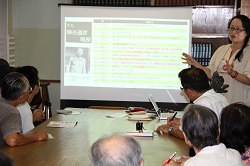
Dr. Akiko Kubota (at right, in rear), Assistant Professor, Research Institute for Radiation Biology and Medicine, explaining about Dr. Hachiya, author of the “Hiroshima Diary”
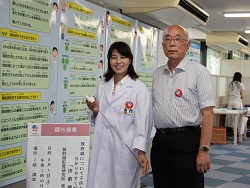
Ms. Reiko Horimukai, Assistant Chief, Public Relations and Publications Office (at left), giving presentation of “School Visit Program,” a project of which she is in charge, assisted by Dr. Norio Takahashi, RERF Consultant
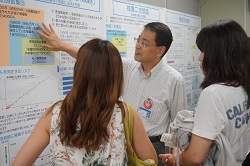
Visitors taking in explanation about RERF’s epidemiological studies
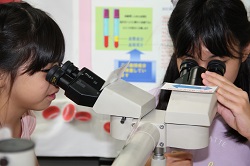
Children peering through microscopes
The 23rd Hiroshima RERF Open House this year included a special exhibit titled “A scrapbook tells the story of how ‘Hiroshima Diary’ reached the world.” In the exhibit a scrapbook was displayed with book reviews and newspaper articles about the English edition of “Hiroshima Diary,” written by Dr. Michihiko Hachiya, who was director of the Hiroshima Teishin Hospital at the time of the atomic bombing. Dr. Akiko Kubota, Assistant Professor, Division of Radiation Information Registry, Research Institute for Radiation Biology and Medicine, Hiroshima University, gave a talk on Dr. Hachiya’s relationship with Dr. Warner L. Wells-a physician who worked at ABCC and who helped translate the book into English-titled “Dr. Wells and Dr. Hachiya-Hiroshima Nikki to Hiroshima Diary.” Visitor comments included the following: “It was a great pleasure to know of the ‘Hiroshima Diary’,” “I want to know more about the translator,” and “Dr. Kubota’s story was very good.”
At the Auditorium, RERF offered a sample school lesson to explain radiation in a simple way for school children. The lesson was presented by Reiko Horimukai, Assistant Chief of the Public Relations and Publications Office and the staff member in charge of the school program. Such lessons are usually held at elementary schools and junior high schools in the city of Hiroshima and surrounding suburbs by staff members who visit the schools from RERF as well as by specialists from other organizations. At the time of the model lesson, the Auditorium was filled with school kids. The children attending the presentation remarked that they wanted RERF to visit their schools to give a lesson, the lesson was interesting and fun, and how they now understood that radiation is everywhere.
In commemoration of ABCC-RERF’s 70th anniversary, Dr. Ohtsura Niwa, RERF Chairman, gave a talk titled “ABCC-RERF’s research and your everyday life.” We received many comments about the lecture: “I found out that RERF’s research is meaningful,” “I learned a lot today such as how research is beneficial to our lives,” and “I learned that the research RERF has long continued is deeply related to the safety and security of our present day lives.”
At the always popular science corner, visitors took part in a liquid nitrogen show, extracted DNA using common food items and tools, used instruments actually employed in the laboratory, and observed tissue underneath a microscope. A quiz rally, whereby participants collected stamps for every correct answer, was as popular as last year. As a first attempt this year, we set up a cloud chamber inside which observation was possible of radiation as it exists in nature; many visitors were on hand to watch radiation made visible by the cloud chamber, which was made with everyday items.
Over the two days this year, 1,383 people attended the Hiroshima Open House. The time spent at RERF per visitor tended to be a bit longer than usual, giving the impression that visitors took their time to enjoy the experience. Many children seemed as if they were having fun at the event. In addition, creating more space in front of the exhibition panels by improving the display method and placement worked out well, resulting in more chances for staff and visitors to communicate. All the planned events and exhibits were well attended.
On behalf of all RERF staff, I would like to thank everyone as Chairperson of the 2017 Open House Working Committee for coming to the Open House this year, despite the intense summer heat.
Nagasaki Open House (August 8 and 9; Kunio Yamaguchi, Chairperson, Nagasaki Open House Working Committee)
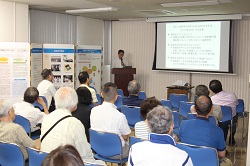
Scene of “ABCC-RERF research and your everyday life,” presented by Dr. Ohtsura Niwa (in center), RERF Chairman
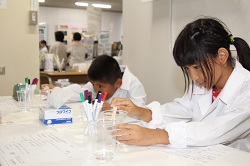
Children participating in color separation experiment with water-based magic markers
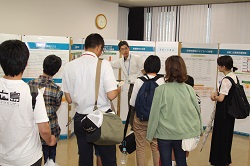
Explanation being given about RERF’s Adult Health Study
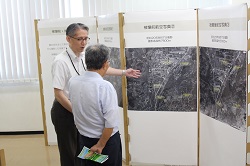
Visitor listening to explanation of aerial photographs taken before and after the A-bombing
We recently held the 21st Open House at Nagasaki RERF. On the first day, August 8, 397 people attended the event, and on the second day, August 9, 211 visitors made it despite the rainy weather in the morning hours, resulting in a total of 608 visitors for both days.
This time, under the theme “This summer, discover RERF,” there were a number of exhibits in the exhibition room, such as “History of the Radiation Effects Research Foundation” and “RERF studies and results-Studies on atomic-bomb survivors, studies on atomic-bomb survivors’ children.” In addition to an exhibit of historical information about the period from the time of the Atomic Bomb Casualty Commission (ABCC), RERF’s predecessor organization, to RERF, and an exhibit of historical photographs dating from that time, a special exhibit titled “Epidemiological Study of Health Effects in Fukushima Emergency Workers” was also on display.
On the second day this year, which marks the 70th anniversary of ABCC-RERF’s establishment, Dr. Ohtsura Niwa, RERF Chairman, presented a talk titled “ABCC-RERF research and your daily life.” The presentation venue was filled with people who actively asked questions and later wrote their impressions on a questionnaire. “I listened with great interest,” wrote one visitor.
Among the experience-based activities, arteriosclerosis testing, bone density measurements, body fat tests, and others proved to be popular. Survey responses we received included: “I was happy I could find out about my own health by undergoing various tests; I’ll certainly pay attention to the advice I received.” Children who needed ideas for their own school science projects observed experiments using liquid nitrogen, a demonstration of pen ink separation, and erythrocytes and leucocytes in blood with a microscope. “My child was too excited for the liquid nitrogen experiments to get sleepy; we actually had lots of fun.” Everyone, from children to adults, seemed to truly enjoy the Open House.
This year, possibly thanks to Chairman Niwa’s special lecture, the number of visitors surpassed that of last year, and as a result, Nagasaki RERF notched the third highest number of Open House visitors ever. We received many comments from guests, like the following: “I’m glad I got the chance to see the facilities, which I typically cannot experience,” “I visit the Open House each year and each year I learn something new,” and “I believe that managing and studying the data of the atomic bomb survivors and their children is necessary.” Many people visited for the first time, making this year’s Open House a good opportunity for visitors to discover RERF this summer, consistent with the event’s theme.
For all of our directors and employees, I express my sincere gratitude to everyone who came to the Nagasaki RERF Open House.
